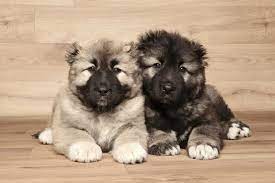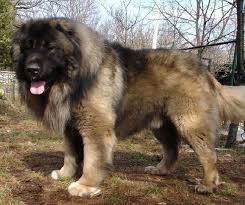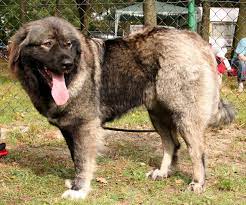Russian Bear Dogs, also known as Caucasian Shepherd Dogs or Caucasian Mountain Dogs, are a distinct breed known for their impressive size, protective nature, and dense fur. It is important to note that they are different from other breeds such as the King Shepherd or Shiloh Shepherd, although they may be confused with them at times.
Table of Contents
These dogs are registered as Caucasian Ovcharka in the United Kennel Club (UKC) and as Caucasian Shepherd Dog in the American Kennel Club (AKC). They have gained a reputation for their imposing stature and strong protective instincts.
Their large size and thick fur give them a majestic appearance, but their protective nature makes it important to consider their suitability as pets. Russian Bear Dogs are known to be highly protective and cautious, which can make them potentially challenging to handle and train.
Whether they are pet-friendly or not depends on various factors, including their socialization, training, and individual temperament. Proper training and socialization from an early age are crucial to ensure they develop into well-behaved and well-adjusted dogs.
To gain a better understanding of Russian Bear Dogs and their unique characteristics, further research and consultation with reputable breeders or experienced dog owners can provide valuable insights. It is essential to consider the specific needs, temperament, and suitability of any breed before bringing them into a household or family environment.

An Overview of Russian Bear Dog
Before delving further, let’s briefly overview this particular dog breed.
| Common Names | Russian bear dog, Caucasian shepherd dog, Caucasian mountain dog, Caucasian ovcharka dog |
| Origin | Southern Russia, Caucasus |
| Breed Group | Working dog |
| Height | 23–30 inches |
| Size | Large |
| Weight | 99–170 pounds |
| Colors | Brown, gray, black, cream, white, brindle, fawn, apricot |
| Nature | Intelligent and easy to train |
| Coat | Double coat, medium-to-long length |
| Life expectancy | between 10 and 12 years |
| Temperament | Loyal, alert, aloof, energetic, confident, protective |
| Shedding | Heavy shedders |
| Barking tendency | Moderate |
| Cost | $1,200–$3,000 |
History of Russian Bear Dog
Russian Bear Dogs, also known as Caucasian Shepherd Dogs or Caucasian Ovcharkas, have a long history as working dogs. They were originally bred and used as protectors of flocks, specifically guarding sheep from large predators like bears, wolves, and jackals. These dogs were not used for herding, but rather their primary role was to protect the livestock.
The breed was initially known as ovcharka dogs, which means “sheepdog” in Russian. As their reputation for protective instincts and loyalty grew, they became recognized as Caucasian shepherd Dogs, reflecting their role as working companions of shepherds.
In the early 20th century, the Soviet Union recognized the valuable qualities of the Caucasian Shepherd Dogs and began breeding them to protect government facilities and factories. This expanded their range beyond the Caucasus Mountains to regions throughout Russia, Georgia, Azerbaijan, Germany, and other parts of Europe.
The breed gained recognition outside of the Soviet Union when it started appearing in Germany in the 1930s as guard dogs. Over time, Russian Bear Dogs gained popularity for various roles, including bear-hunting dogs, prison guards, and even pets. In 1984, the breed was officially accepted by the Federation Cynologique Internationale (FCI), a global canine organization.
Today, Russian Bear Dogs are known worldwide and are used as companion dogs, watchdogs, and property guardians. They retain their protective instincts and are still employed by shepherds to protect their sheep flocks.
It is important to note that due to their protective nature and large size, Russian Bear Dogs require experienced handling, proper training, and socialization. Potential owners should thoroughly research the breed, understand their needs, and ensure they can provide a suitable environment for these remarkable and imposing dogs.
Russian Bear Dog Appearance
Russian Bear Dogs, also known as Caucasian Shepherd Dogs or Caucasian Ovcharkas, indeed possess several distinctive physical attributes that contribute to their formidable appearance and protective capabilities.

Size and Weight: Russian Bear Dogs are large and robust dogs, often reaching sizes comparable to small bears. The height of these dogs can range from 20 to 30 inches, with males typically being taller than females. They are known for their muscular build, with weights ranging from 99 to 170 pounds. The size and weight of individual dogs can vary based on factors such as genetics, diet, and overall health.
Coat and Colors: The coat of Russian Bear Dogs is dense, double-layered, and designed to withstand harsh weather conditions. The underlayer is soft and insulating, while the outer layer is coarse and protective. The color of their coats can vary greatly, including white, grey, cream, black, fawn, apricot, or rusty red-brown shades. The most common color combinations are white, black, or brindle. Solid-color coats are relatively rare in this breed.
Head and Facial Features: Russian Bear Dogs have broad faces with deep-set dark, oval-shaped eyes. Their strong muzzle tapers off to a nose, and they possess sharp, pointed teeth that aid in their protective nature. Their ears have historically been cropped in some regions to protect them from potential injuries during confrontations, although this practice is now considered unnecessary by many veterinarians.
It is important to note that Russian Bear Dogs require proper training, socialization, and responsible ownership due to their size and protective instincts. They are not recommended for first-time dog owners or those who are unable to provide the necessary physical and mental stimulation these dogs require.
While they possess an impressive appearance, it is essential to understand that their physical attributes are a result of their working heritage and not solely for aesthetic purposes. Responsible ownership and understanding the breed’s specific needs are crucial for the well-being and happiness of Russian Bear Dogs.
Russian Bear Dog Temperament and Personality

Due to their historical role as guardians and watchdogs, Russian Bear Dogs are often perceived as aggressive or unfriendly. However, their personality and temperament are more complex than that. These dogs are active and have a strong instinct to protect. They have a history of being bred alongside sheep to develop an affiliation with them and differentiate between predators and the flock. This background highlights their devoted and protective nature. They are loyal to their owners and familiar individuals but may be cautious around strangers.
In terms of personality, Russian Bear Dogs are active, intelligent, alert, and loyal. Training them can be challenging due to their independence and alertness, but their intelligence allows them to learn quickly. Proper training and socialization can help them channel their protective instincts without being aggressive or violent. It is important to note that training does not eliminate their protective nature, but rather teaches them to use it appropriately.
Despite their protective instincts, Russian Bear Dogs do not bark excessively. They are not prone to barking out of boredom or anxiety. They typically bark to alert their owners of strangers or potential threats. Early socialization and training can help manage their barking tendencies, ensuring they are only alert when necessary.
Overall, Russian Bear Dogs have unique personalities and make great companions for those who understand and appreciate their protective nature. Proper training, socialization, and understanding of their needs are essential to having a well-behaved and balanced Russian Bear Dog.
Common Health Issues in Russian Bear Dogs
As previously mentioned, Russian Bear Dogs are generally considered a healthy breed with a lifespan of around 12 years. However, there are a few health complications that they may be susceptible to. These include
Hip Dysplasia: Hip dysplasia is a common health issue in large-sized dogs, where the hip joints become loose, causing dysfunction and pain. Overexercising at a young age is a significant contributing factor. It is important to avoid excessive exercise during the puppy stage. Gradually increasing exercise duration as the puppy grows is recommended. Symptoms of hip dysplasia include stiffness, difficulty moving, lethargy, and irritability.
Obesity: Obesity is another common health concern in giant-sized dogs, primarily caused by a lack of exercise and improper diet. Monitoring their food intake and providing a balanced, low-calorie diet is essential. Regular exercise, such as two 15-minute walks per day, can help maintain a healthy weight.
Bloat (Gastric Dilatation and Volvulus – GDV): Bloat is a serious condition where the stomach accumulates gas or fluid, impacting the digestive system. It can be life-threatening if not treated immediately. Symptoms of bloat include a swollen and hard belly, retching without vomiting, excessive drooling, panting, and restlessness. To reduce the risk of bloat, it is recommended to feed multiple small meals throughout the day and avoid vigorous exercise immediately before and after meals.
It is crucial to note that regular veterinary check-ups, proper nutrition, exercise, and early detection of any health issues are vital in ensuring the well-being of Russian Bear Dogs.
Feeding Russian Bear Dogs
Russian Bear Dogs require a well-balanced and nutrient-dense diet to maintain their health and well-being. Their diet should primarily consist of animal protein and healthy animal-based fats. While standard meats like chicken and beef are good options, it’s essential to prioritize quality over quantity. These giant-sized breeds are more vulnerable to obesity, so it’s crucial to give them the right kind of food with optimal nutrition.
Legumes, peas, and potatoes are known to cause problems in certain individuals, so it’s best to avoid these foods in your dog’s diet. Providing your furry friend with a healthy and balanced diet will not only prevent health issues but also enhance their lifespan. As responsible pet owners, it is our responsibility to provide them with the best possible care, starting with a nutritious diet.
Should I Adopt a Russian Bear Dog as a Pet?
Before considering adopting a Russian Bear Dog, it is essential to carefully evaluate the following points:
- Living Environment: Russian Bear Dogs require a spacious living environment with a large yard where they can roam and play freely. They are not suitable for apartments or small houses without fenced outdoor areas. Additionally, their intolerance towards strangers may cause issues in apartment settings.
- Experience as a Dog Owner: These dogs have a stubborn and independent nature, requiring experienced dog owners who can handle their aggression and stubbornness. If you are a new dog owner with no prior experience, it may be challenging to manage their behavior.
- Pros and Cons: Consider the advantages and disadvantages of owning a Russian Bear Dog. The pros include their excellent guarding abilities, unique appearance, loyalty to their family, intelligence, moderate exercise requirements, and overall good health. However, the cons include their unsuitability for inexperienced owners, extreme aggression towards strangers, not being recommended for families with children, difficulty in training, the need for a large yard and high fence, and the requirement for regular grooming.
It is crucial to thoroughly understand the responsibilities and challenges that come with owning a Russian Bear Dog before making the decision to adopt one. Proper care, training, socialization, and meeting their specific needs are essential to ensure a harmonious and fulfilling relationship with this remarkable breed.
FAQs
What is a Russian bear dog?
This dog was bred to protect their owners from predators like wolves and, yes, even bears. They are known for their fierce loyalty and fearlessness, making them excellent guard dogs. However, potential owners should understand that this breed requires extensive socialization and training to control their protective instincts.
What breeds are Russian bear dogs?
Originating from the Caucasus region, this breed can weigh up to 170 pounds and grow to be up to 30 inches tall at the shoulder. These are powerful and intelligent dogs that have a thick coat of fur protecting them from the harsh winters of their homeland. With their alert and confident demeanor, Russian bear dogs make excellent watchdogs and loyal companions.
Is the Russian bear dog the biggest dog?
While not technically the biggest dog, the Russian bear dog, also known as the Caucasian Shepherd, is a massive breed that can weigh up to 200 pounds and stand over 2 feet tall at the shoulder. They were originally bred to protect livestock from dangerous predators, so it’s no surprise they have a reputation for being fiercely protective of their owners.
Final words
In summary, Russian Bear Dogs are large, muscular dogs bred to protect flocks of sheep. They were historically used by shepherds and later by the Soviet Union for guarding purposes. These dogs have a powerful and robust appearance, making them suitable for facing large predators like wolves. However, they may be prone to health issues such as hip dysplasia, obesity, and bloat.
If you are considering owning a Russian Bear Dog, it is important to consider three key factors: your living environment, your experience as a dog owner, and the pros and cons associated with this breed. They require a spacious living environment with a large yard, and they are better suited for experienced dog owners due to their stubbornness and independent nature. Understanding the potential challenges and advantages of owning a Russian Bear Dog will help you make an informed decision.
Reference:
A motivated philosophy graduate and student of wildlife conservation with a deep interest in human-wildlife relationships, including wildlife communication, environmental education, and conservation anthropology. Offers strong interpersonal, research, writing, and creativity skills.










